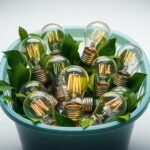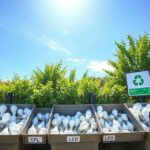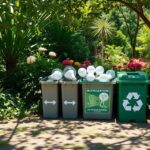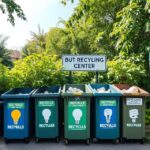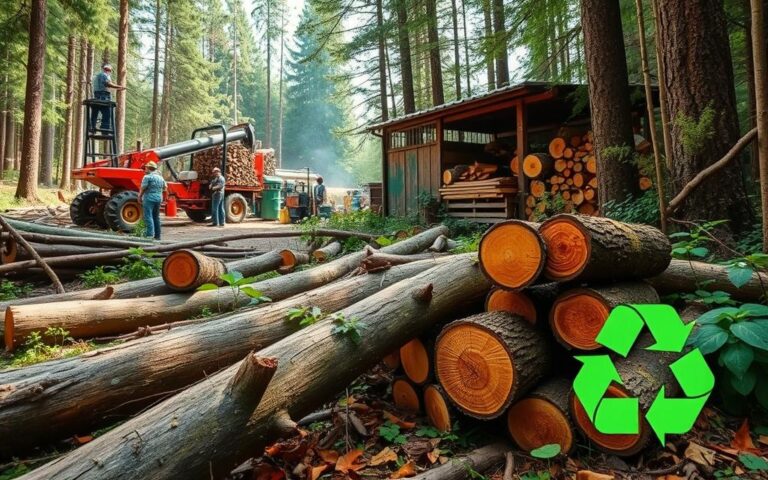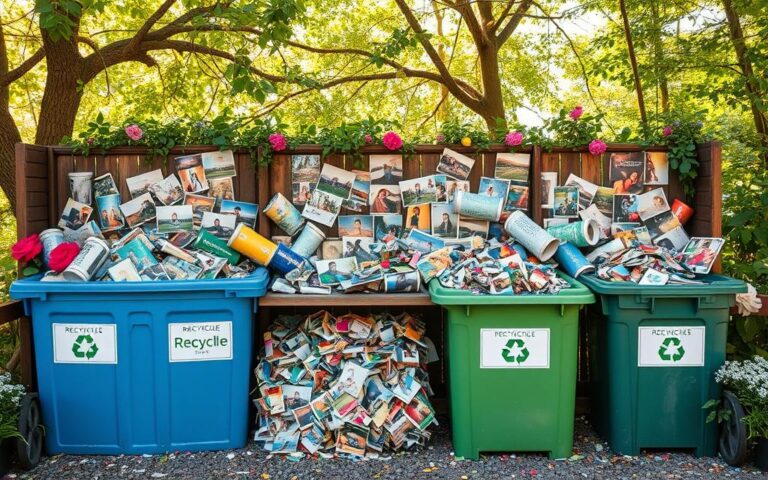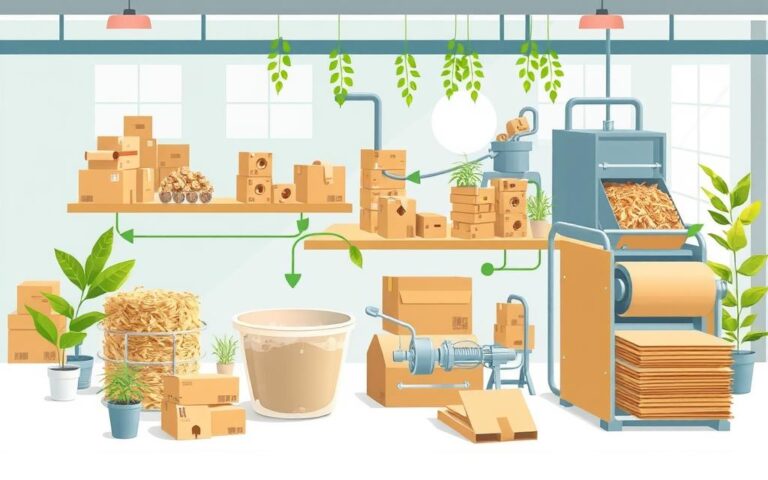How to Recycle Fluorescent Light Bulbs Safely
Fluorescent light bulbs, including compacts and tubes, are 75% more efficient than old-style incandescent ones. But, it’s vital to recycle them the right way. They have mercury, which can harm us and our world. Knowing how to properly get rid of them helps keep the environment safe. Plus, replacing a regular bulb with a fluorescent one cuts down 150 pounds of CO2 a year.
Even with their benefits, only a third of these mercury bulbs get recycled. This shows we need to be better informed on how to dispose of them safely. By doing so, we stop mercury from polluting our lands and waters. This protects animals and makes a healthier earth for everyone in the future.
Understanding the Importance of Recycling Fluorescent Light Bulbs
Fluorescent light bulbs save energy and last much longer than old-style bulbs. However, if we don’t dispose of them safely, they can harm both people and animals. They contain a small amount of mercury, around 4 to 5 milligrams in new models. This can cause serious environmental damage if the bulbs are thrown out carelessly.
Health Risks of Improper Disposal
When these bulbs break or aren’t thrown away properly, they can be dangerous. Mercury can get into the water, harming wildlife and people’s health. It’s particularly harmful to children’s brain development. That’s why some places have laws against tossing these bulbs in the bin. It’s very important to recycle them correctly. Websites like recycling benefits teach us how to do this right.
Environmental Impact of Mercury
Mercury’s impact on the environment is too big to ignore. It threatens our health and the planet. The EPA says fluorescent bulbs must be treated as hazardous waste. Recycling them stops mercury pollution and reduces air and water pollution too. By recycling correctly, we keep dangerous materials away from landfills and handle them safely.
How to Recycle Fluorescent Light Bulbs
Recycling fluorescent light bulbs is key to protecting the environment and following laws. Learning how to ready bulbs for recycling ensures safety and efficiency. Here’s how to prepare and store them properly.
Steps for Safe Preparation
Prepare fluorescent bulbs carefully before recycling. The steps include:
- Wear protective gloves to avoid touching the bulbs directly.
- Put the bulbs in safe containers, like padded boxes or plastic bags, to prevent them from breaking during transport.
- Make sure the containers are closed well to stop any materials from escaping.
- Write on the containers that they have fluorescent bulbs before taking them to recycling places.
Containers Suitable for Storage
Finding the right container for bulb storage is vital. The options are:
| Container Type | Description |
|---|---|
| Padded Boxes | They offer extra safety against breaking while moving. |
| Plastic Bags | These can be sealed well; make sure they’re tough enough for the bulbs. |
| Pre-Printed Recycling Kits | They’re provided by companies like BulbCycle, including containers and instructions. |
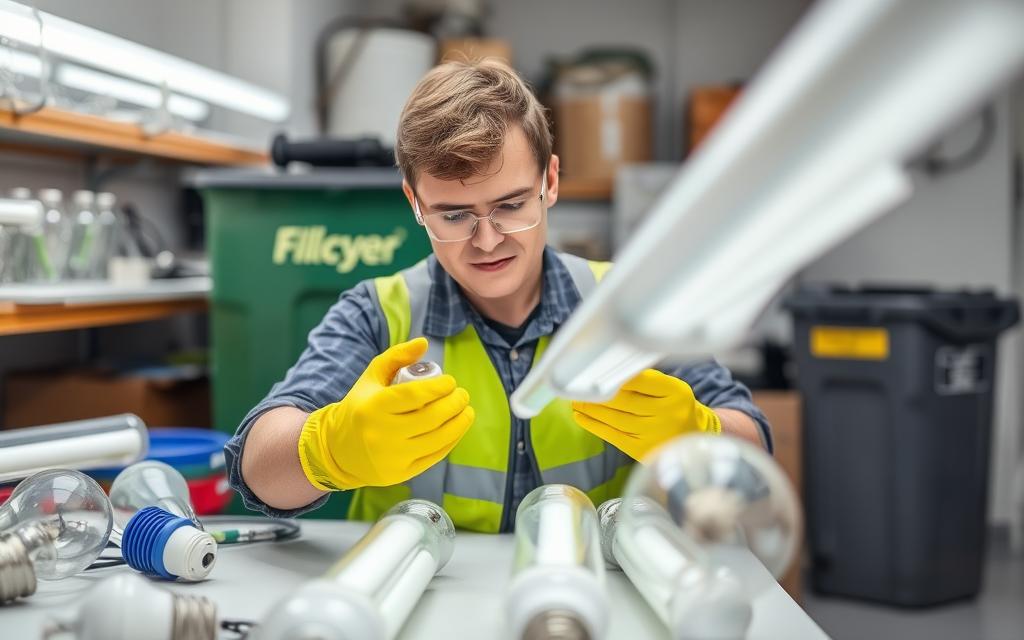
Where to Dispose of Fluorescent Light Bulbs
Finding recycling locations for fluorescent bulbs is vital. These bulbs have harmful materials. It’s important to dispose of them safely. You have lots of options, like local recycling centres, retail programmes, and special waste facilities.
Local Recycling Centres
Your local area likely has recycling centres for these bulbs. They know how to safely deal with the hazardous stuff inside. To find where to recycle light bulbs, check your council’s website. Or you can call your local environmental group. Here’s what these centres usually offer:
- Convenient drop-off points
- Scheduled collection events for hazardous waste
- Professional handling of toxic materials
Retailer Recycling Programmes
Shops like Home Depot and Lowe’s have special bins for recycling CFLs and sometimes tubes. Dropping off your bulbs there means they’ll get processed the right way. These places are great recycling locations for fluorescent bulbs, easy to use:
| Retailer | Accepted Bulb Types | Drop-off Method |
|---|---|---|
| Home Depot | CFLs, Fluorescent Tubes | In-store Drop-off |
| Lowe’s | CFLs | In-store Drop-off |
Household Hazardous Waste Facilities
If you’ve got lots of bulbs, or broken ones, check out hazardous waste facilities. They hold collection events now and then. It’s best to check when these happen. This way, your bulbs get disposed of safely:
- Periodic events for special waste collection
- Trained personnel for handling hazardous materials
- Compliance with local and federal regulations
Safety Precautions When Handling Bulbs
It’s vital to be safe while handling fluorescent light bulbs because they can be dangerous. This section explains key precautions broken bulbs to reduce risks. It shows why protective steps are important.
Dealing with Broken Bulbs Safely
If a bulb breaks, it’s crucial to follow certain precautions broken bulbs to avoid mercury exposure and injuries. Here’s what you should do:
- Make sure children and pets leave the area right away.
- Open windows and doors to get fresh air in.
- Don’t use a vacuum or broom as it can spread mercury.
- Use damp paper towels or sticky tape to pick up pieces.
- Put the pieces and cleaning materials in a sealed plastic bag for disposal.
Using Protective Gear
Wearing suitable protective gear for recycling is key when dealing with fluorescent bulbs. The right gear greatly lowers the risk of injuries or coming into contact with harmful substances:
- Gloves: Wear nitrile or rubber gloves for hand protection.
- Protective eyewear: Safety glasses protect your eyes from glass bits.
- Dust masks: Masks block inhaling fine particles during cleanup.
By sticking to these safety handling fluorescent bulbs tips, you help make things safer and encourage proper disposal. These safety practices look after your health and support environmental aims too.
| Safety Precaution | Details |
|---|---|
| Area Clearance | Get children and pets out immediately. |
| Ventilation | Open windows to let in fresh air. |
| Safe Cleaning | Pick up debris with damp paper towels. |
| Protective Gear | Dress in gloves, safety glasses, and dust masks for handling and cleanup. |
Legal Requirements for Disposal
It’s key to know the legal side of disposing fluorescent bulbs to recycle responsibility. These bulbs, like compact fluorescent lamps (CFLs) and tubes, have mercury which is bad for our planet if not thrown away correctly. Following local laws on how to recycle these bulbs is vital. It ensures the harmful materials are dealt with right and keeps people safe.
Understanding Local Regulations
Different areas have their own rules for getting rid of fluorescent bulbs safely. The local waste management authorities can give you the latest on these laws. It’s super important to check these before you throw bulbs away. Many places say these bulbs are hazardous waste, so you can’t just put them in the bin. If you don’t follow these rules, you could end up paying a lot in fines.
Consequences of Improper Disposal
Throwing away fluorescent bulbs the wrong way can lead to big fines. Places often check to make sure everyone’s following the rules. If you’re caught not doing this, the fines can be hefty. People know more now about how this affects our planet. So, recycling these bulbs right is not only following the law but also doing the right thing for everyone.
To wrap up, following local laws on disposing of fluorescent bulbs avoids fines for improper disposal. It also helps keep our environment safe. Learning about how to deal with hazardous waste properly is a step towards better, more sustainable living.
Conclusion
Recycling fluorescent bulbs is important. It helps us follow rules, benefits the environment, and protects our health. Knowing how to properly get rid of these bulbs reduces the risk from mercury. This dangerous substance is found in many bulbs.
By using special recycling centres and joining local efforts, we keep harmful materials out of landfills. This prevents them from polluting our soil and water. Safe disposal of bulbs is key to protecting our health and raising awareness about environmental dangers.
Fluorescent bulbs are widely used because they are efficient. But, it’s vital that everyone knows how to dispose of them correctly. This keeps us all safer and our environment cleaner.
Learning and teaching others about bulb recycling shows we care about our planet. Small actions by each of us can make a big difference. Let’s work together for a brighter, cleaner future.
FAQ
Why is it important to recycle fluorescent light bulbs?
Recycling fluorescent bulbs is key because they have mercury, which is dangerous. This keeps mercury from getting into our water and helps the environment.
What health risks are associated with improper disposal of fluorescent bulbs?
When not disposed of right, broken bulbs release mercury. This can harm children’s brains and wildlife health. Such dangers threaten our ecosystems and well-being.
How should I prepare fluorescent bulbs for recycling?
Be careful with fluorescent bulbs. Wear gloves and put them in boxes or plastic that’s well sealed. Always label these containers clearly before recycling them.
Where can I recycle fluorescent light bulbs?
You can take them to local recycling spots, stores like The Home Depot, and special hazardous waste places. They handle both intact and broken bulbs safely.
What precautions should I take when handling broken fluorescent bulbs?
If a bulb breaks, first make sure people and pets are out of the room. Open windows for fresh air. Don’t use a vacuum or broom. Pick up pieces with damp paper or tape. Always use gloves and something to protect your eyes.
What are the legal requirements for disposing of fluorescent light bulbs?
Throwing fluorescent bulbs in the bin is often illegal because they’re hazardous. Check local rules to avoid fines. This helps you follow the law and be responsible.
What are the consequences of improper disposal?
Getting rid of bulbs the wrong way can lead to fines and legal trouble. It breaks local laws. Knowing these rules helps us all recycle better.


